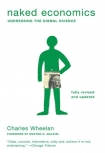Naked Economics by Wheelan, Charles (spanish books to read .txt) 📕

Read free book «Naked Economics by Wheelan, Charles (spanish books to read .txt) 📕» - read online or download for free at americanlibrarybooks.com
Read book online «Naked Economics by Wheelan, Charles (spanish books to read .txt) 📕». Author - Wheelan, Charles
Demographics. Americans are getting older, literally. As economist Paul Krugman has noted, the age distribution in America will eventually begin to look as it does in Florida. That is good for the companies that manufacture shuffleboard equipment. It is not so good for government finances. The bulk of government benefits, notably Social Security and Medicare, are bestowed on Americans who are retired. These programs are financed with payroll taxes imposed on younger Americans who are still working. If the ratio of young Americans to older Americans begins to change, then the financial health of programs like Social Security and Medicare begins to change, too.
Indeed, we can explain the importance of demographics and fix Social Security all in the next two paragraphs. Social Security is a “pay-as-you-go” program. When American workers pay into Social Security (that large FICA deduction on your paycheck), the money does not get invested somewhere so that you can draw on it twenty or thirty years later, as it would in a private pension fund. Rather, that money is used to pay current retirees. Straight from young Peter to old Paul. The program is one big pyramid scheme, and, like any good pyramid scheme, it works fine as long as there are enough workers on the bottom to continue paying the retirees at the top.
Therein lies the problem. Americans are having fewer children and living longer. This shift means that there are fewer workers to pay for every retiree—a lot fewer. In 1960, there were five workers for every retiree. Now there are three workers for every retiree. By 2032, there will be only two. Imagine Social Security (or Medicare) as a seesaw in which payments made by workers are on one side and benefits collected by retirees are on the other. The program is solvent as long as the seesaw balances. As the number of workers on one side shrinks while the number of retirees on the other side grows, the seesaw begins to tip. In theory, fixing the problem is easy. We can take more from current workers, either by increasing the payroll tax or by making them more productive and raising their incomes (so that the same tax generates more revenues). Or we can give less to retirees, either by cutting their benefits or by raising the retirement age. That is the very simple economic crux of the problem. Of course, if you think any of these solutions would be politically palatable, please go back and read Chapter 8 again.
Total national happiness. You decide. We don’t have a number for that one yet.
An autoworker in Detroit who has spent his career getting laid off for months at a time and then called back to work is going to ask a simple question: Are we getting any better at all of this? Yes, we are. The United States has gone through eleven recessions since World War II.19 None, including the recession that began in 2007, is even of the same order of magnitude as the Great Depression. From 1929 to 1933, real GDP fell by 30 percent while unemployment climbed from 3 percent to 25 percent. Prior to the Great Depression, the United States regularly experienced deep recessions, including financial panics, far worse than what we’re going through now.20 We haven’t made the economic bumps go away, but they are smaller bumps.
One can also argue that what we’ve learned from past economic downturns, and the Great Depression in particular, has helped with policies this time around. Fed chairman (and former Princeton professor) Ben Bernanke is a scholar of the Great Depression. So is Obama’s chair of the Council of Economic Advisers (and former UC Berkeley professor) Christina Romer. I can promise you that economists will still be arguing fifty years from now about what should or shouldn’t have been done in response to the recession and subsequent financial crisis. However, even the toughest critics should concede that officials at the end of the Bush administration and the beginning of the Obama administration avoided the worst mistakes of the 1930s, when the Federal Reserve raised interest rates in the face of the Great Depression and Congress raised taxes—thrusting both monetary and fiscal policy in the wrong direction.
There is something to be said for not doing exactly the wrong thing. I suspect history will judge that policymakers did even better than that.
CHAPTER 10
The Federal Reserve:
Why that dollar in your pocket is more than just a piece of paper
Sometimes simple statements speak loudly. On September 11, 2001, hours after the terrorist attacks on the United States, the Federal Reserve issued the following statement: “The Federal Reserve System is open and operating. The discount window is available to meet liquidity needs.”
Those terse and technical two sentences had a calming effect on global markets. The following Monday, as America’s markets opened for their first trading sessions after the attack, the Federal Reserve cut interest rates by 0.5 percent, another act that moderated the financial and economic impact of the terrorist assaults.
How exactly does an inelegant two-sentence statement have such a profound effect on the world’s largest economy—indeed, on the whole global economy?
The Federal Reserve has tools





Comments (0)